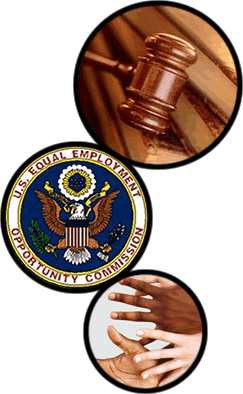Equal Rights and Opportunity in the Labor Force
- Fighting Sexual Discrimination -
Main | Entering the Workforce | Careerism | Fighting Sexual Discrimination | Key Victories | Additional Resources | Glossary
|
|
Title VII of the Civil Rights Act of 1964Many women have been able to challenge barriers that prevent women from fairly entering the labor market through Title VII of the Civil Rights Act of 1964. Title VII of the Civil Rights Act of 1964 prohibits labor market discrimination "against individuals by covered employers on the basis of race, color, religion, sex or national origin."[1] Under Title VII, individuals cannot be discriminated against in the workplace for any of these reasons, including one's association with another individuals of a particular race, color, religion, sex, national origin, or based on the individual's interracial association or interracial marriage to another. Sexual harassment is also included as a form of discrimination, because it that affects an individual's employment and performance. The Equal Employment Opportunity Commission (EEOC)Title VII of the Civil Rights Act of 1964 is exercised primarily by the Equal Employment Opportunity Commission to represent and protect individuals. The Equal Employment Opportunity Commission is a United States federal agency that serves to end employment discrimination through bringing lawsuits on behalf of alleged victims of discrimination against private employers.[2] Though it monitors discrimination through different acts, such as the Equal Pay Act, the EEOC works primarily through Title VII of the Civil Rights Act of 1964. Working alongside state fair employment practices agencies (FEPAs), the EEOC investigates, mediates, and helps individuals file lawsuits against employers. In order to exercise one's rights to file a lawsuit, an individual must file a complaint of discrimination within 180 days of learning of the discrimination. Please refer to the Additional Resources page for more information. Affirmative Action Though affirmative action was initially an approach utilized by civil rights efforts to ensure the equal rights and opportunities of African Americans as full citizens of the United States, this principle has evolved to apply to a range of institutions including the labor force. Affirmative action is defined as "pro-active steps to erase differences between women and men, minorities and nonminorities, etc." [3] in the labor market. Often times, employers set out goals or guidelines based on estimates of the availability of the protected groups for similar types of positions, and set reasonable time goals to meet them. The setting of such goals has had a positive effect on the employment of minorities and women in the labor force. Yet despite the existence of such legislation, the battle against sexual discrimination is still being fought. Over the years, much progress has been made on account of Equal Opportunity Feminism, with many important Key Victories that set precedent for future efforts. At the same time, as we will see, there is still much to be done. |
References
[1] Equal Employment Opportunity Commission Website, "Title VII of the Civil Rights Act of 1964," 18 May 2007 <http://www.eeoc.gov/policy/vii.html>.
[2] Equal Employment Opportunity Commission Website, "Federal Laws Prohibiting Job Discrimination," 18 May 2007 <http://www.eeoc.gov/facts/qanda.html>.
[3] Blau, Francine D., Marianne A. Ferber, and Anne E. Winkler. The Economics of Women, Men, and Work. 5th ed. Upper Saddle Riber, NJ: Pearson Prentice Hall, 2006. 242.
- Table of Contents - |
|

